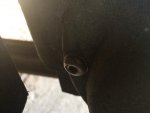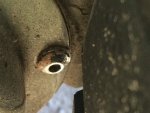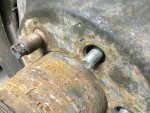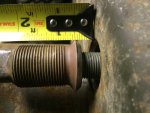Reporting back as promised...
The center axle takes the brunt of the sideways force when turning left or right and on my truck (that I've used a 1/4" thick spacer plate on both rear axles) the center axle still showed signs of tire wearing on the trunnion cap and bolt head.
Center Axle, Driver's Side:
As can be seen, the tire is still rubbing on the trunnion cap bolt head and maybe even some on the trunnion cap itself. The tire tread is starting to lose small chunks on the very corner edge.


Center Axle, Passenger's Side:
The tire is also still rubbing on the trunnion cap bolt head and the edge of the trunnion cap itself. The tire tread is starting to lose small chunks on the very corner edge. This wear appears to be slightly less than on the driver's side.

Rear-most axle, Driver's Side:
Kind of dark, but I don't see any wearing on the bolt head or tire edge.

Rear-most axle, Passenger's Side:
Surprisingly looks a bit rusty (maybe it's just dirt! I didn't rub it with my finger to check), but that also shows that there doesn't appear to be any wear on the bolt head or tire.

My conclusion:
- 1/4" thick spacer plate appears to be sufficient for the rear-most axle, in over-the-road driving.
- It appears that a 1/2" thick spacer plate would be needed to stop (or mostly stop) the rubbing of the center axle.
- The "button" head bolts were definitely a good thing to do on all sides, regardless of spacer plate thickness used.
If you want to keep prices down I don't see significant harm being done to the tire or trunnion cap with the use of 1/4" plate. Though if the paint disappears, rust will eventually form. Another cost saving option is that you could order thicker plates for the center axle and 1/4" plates for the rear-most axle.
If I had to do it over, I
might go with 3/8" plate all around. Though, 1/2" plate may also still be safe but I don't recall how much thread was left.
Update: See three posts later of a measurement of the remaining threads with a 1/4" spacer plate on stock studs:
http://www.steelsoldiers.com/showth...-G-177-tires&p=1840048&viewfull=1#post1840048
If you wanted to wait yet again, I can measure the threads as I need to disassemble my passenger center axle as I believe I have a blown wheel/brake cylinder.


















